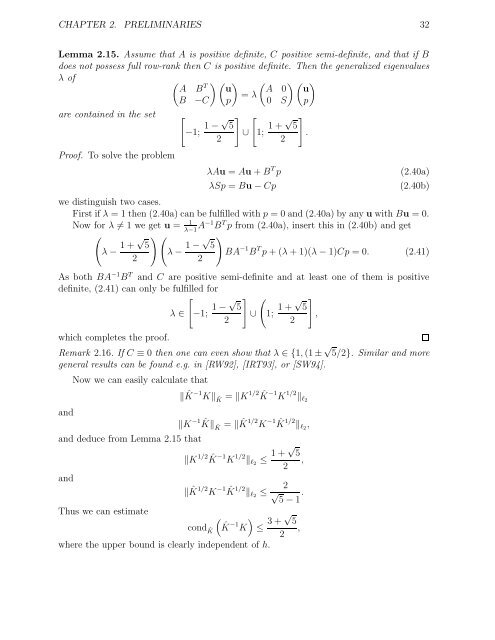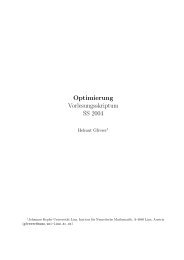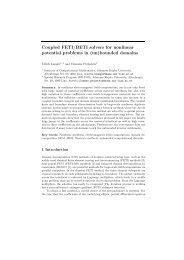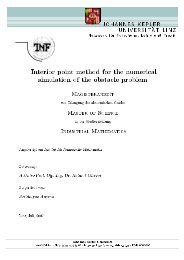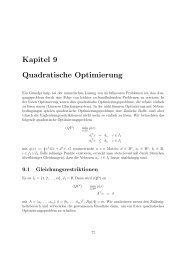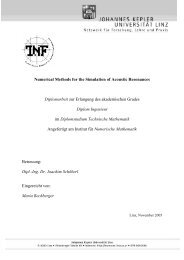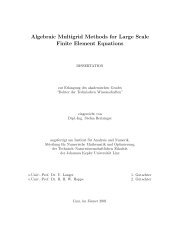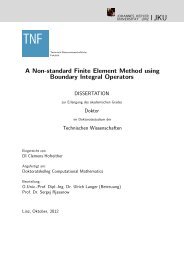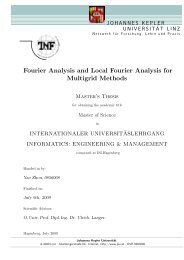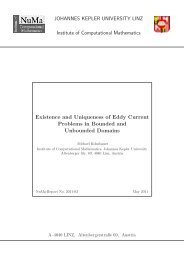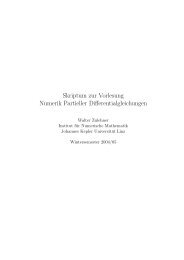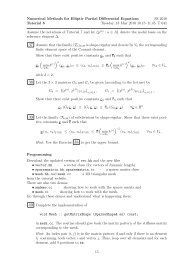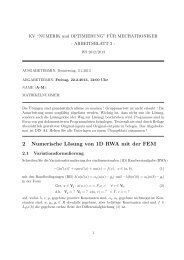PDF file - Johannes Kepler University, Linz - JKU
PDF file - Johannes Kepler University, Linz - JKU
PDF file - Johannes Kepler University, Linz - JKU
You also want an ePaper? Increase the reach of your titles
YUMPU automatically turns print PDFs into web optimized ePapers that Google loves.
CHAPTER 2. PRELIMINARIES 32<br />
Lemma 2.15. Assume that A is positive definite, C positive semi-definite, and that if B<br />
does not possess full row-rank then C is positive definite. Then the generalized eigenvalues<br />
λ of ( ( ) ( ( )<br />
A B<br />
T u A 0 u<br />
= λ<br />
B −C)<br />
p 0 S)<br />
p<br />
are contained in the set [<br />
Proof. To solve the problem<br />
−1; 1 − √ 5<br />
2<br />
]<br />
∪<br />
[<br />
1; 1 + √ 5<br />
2<br />
λAu = Au + B T p<br />
λSp = Bu − Cp<br />
]<br />
.<br />
(2.40a)<br />
(2.40b)<br />
we distinguish two cases.<br />
First if λ = 1 then (2.40a) can be fulfilled with p = 0 and (2.40a) by any u with Bu = 0.<br />
Now for λ ≠ 1 we get u = 1<br />
λ−1 A−1 B T p from (2.40a), insert this in (2.40b) and get<br />
(<br />
λ − 1 + √ 5<br />
2<br />
) (<br />
λ − 1 − √ 5<br />
2<br />
)<br />
BA −1 B T p + (λ + 1)(λ − 1)Cp = 0. (2.41)<br />
As both BA −1 B T and C are positive semi-definite and at least one of them is positive<br />
definite, (2.41) can only be fulfilled for<br />
[<br />
λ ∈ −1; 1 − √ ] (<br />
5<br />
∪ 1; 1 + √ ]<br />
5<br />
,<br />
2<br />
2<br />
which completes the proof.<br />
Remark 2.16. If C ≡ 0 then one can even show that λ ∈ {1, (1 ± √ 5/2}. Similar and more<br />
general results can be found e.g. in [RW92], [IRT93], or [SW94].<br />
and<br />
Now we can easily calculate that<br />
and deduce from Lemma 2.15 that<br />
and<br />
‖ ˆK −1 K‖ ˆK = ‖K1/2 ˆK−1 K 1/2 ‖ l2<br />
‖K −1 ˆK‖ ˆK = ‖ ˆK 1/2 K −1 ˆK1/2 ‖ l2 ,<br />
‖K 1/2 ˆK−1 K 1/2 ‖ l2 ≤ 1 + √ 5<br />
,<br />
2<br />
‖ ˆK 1/2 K −1 ˆK1/2 ‖ l2 ≤<br />
2<br />
√<br />
5 − 1<br />
.<br />
Thus we can estimate<br />
( )<br />
cond ˆK−1 ˆK<br />
K ≤ 3 + √ 5<br />
,<br />
2<br />
where the upper bound is clearly independent of h.


